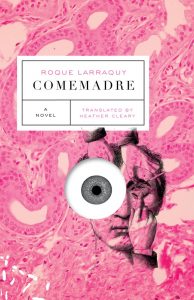Reviewed by Bronwyn Green

How far are you willing to go for science? What about for success? Roque Larraquy’s thrilling novel Comemadre tackles these questions in two interlocking tales one hundred years apart, in only 129 pages. Set in Buenos Aires, Argentina, Comemadre is a thrilling and terrifying account of two men pushing the limits in their fields. The novel certainly has horror film vibes, but also contains a shocking amount of absurdist comedy. From an obsession with women and bidets to a woman’s obsession with flies, there are most definitely stellar comedic moments in this novel.
The first story told in Comemadre revolves around ethics in science. The main character, Dr. Quintana, works at a sanatorium in Buenos Aires in 1907. His story involves competition, attraction, and the pursuit of a rather morbid knowledge. Instead of treating patients for cancer, the doctors at the sanatorium decide to use their patients’ bodies for the greater good: discovering what people see immediately after death. Apparently, the human mind still functions for a few seconds after decapitation and these doctors make it their quest to discover what one sees immediately following death.
These doctors devise a contraption that decapitates a person without damaging their vocal cords, then a vent blows air over them allowing the corpse to speak. Interestingly, they get rather different results from each patient including, “I’d like some water,” “What did you do to my neck?” and one that “screams for nine seconds straight.” Seemingly, death is not the same for everyone.
Throughout their participation in this experiment, these doctors change their views somewhat rapidly. Although some of them are rather keen on this experiment, Dr. Quintana goes about his participation rather passively, until there is an incentive. When there is the promise of a bonus, he and all the other doctors step up their game both for money and to win the heart of the head nurse, Menendez.
Although everyone would love to know what happens after we die, actually finding out seems to be a rather complicated idea. Larraquy’s novel really causes the reader to question how far is too far in the realm of medical science and to take into consideration choosing between ethics and knowledge.
The second section of the novel follows an artist with a complicated past attempting to push the limits of the art scene alongside his doppelganger. The story highlights the artist’s childhood, his battle with obesity, and his discovery of sex all of which contribute to his groundbreaking, albeit disturbing, art projects in his adulthood.
This story questions ethics in a very different manner than Dr. Quintana’s section. Rather than going too far for the sake of scientific knowledge, the unnamed artist goes too far for aesthetics and fame. Although his art installations are striking, they all have one disturbing thing in common: the inclusion of human body parts.
The unnamed artist was a child prodigy whose questionable morals were seen from an early age. His fascination with sex begins while he is quite young but is stifled by his physical appearance. Being morbidly obese, he is unable to find someone to experiment with, so he turns to prostitution. His very first sexual encounter is with a prostitute named Sebastian who plays a much bigger role than is expected.
His fascination with sex leads to a fascination with the human body which is key in his art. From two-headed children to amputated fingers, the artist’s work is rather shocking. His manipulation of both people and situations in order to achieve his artistic goals are troubling, but are a true testament to his ambitious nature. His desire to do something that has never been done before is both compelling and concerning, leaving the reader wondering just how far is he willing to go.
Although this book is a masterpiece in regards to dark comedy, it is only fair to give potential readers a trigger warning. There are some rather disturbing scenes throughout this novel that may make some people uncomfortable. If sexual assault between children or stalking of a woman by her superiors will keep you up at night, this may not be the book for you. Although these scenes are disturbing, they are necessary to the plot and character development. The point of the novel is to make the reader think about issues of desire and ethics which both of these upsetting situations contribute to. Furthermore, neither of the main characters can exactly be considered protagonists and these uncomfortable situations play a crucial role in the reader’s understanding of their characters.
Ultimately, Comemadre is an incredibly intriguing and dark work that truly causes the reader to consider ethics versus progress. Reading the accounts of Dr. Quintana and the nameless artist allows the reader to compare and contrast the two characters and decide if either of them made the right decisions. If you enjoy absurdism and novels that make you evaluate philosophical moral issues, the Roque Larraquy’s Comemadre is your next read.
